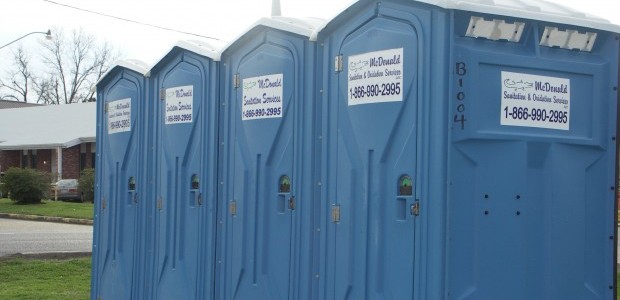
Nicholls baseball hungry for more in 2012
February 14, 2012
‘Deathtrap’ shows intricacy of hidden motivation
February 14, 2012Sure, it is Carnival time and Mardi Gras Day will be here before we know it. Everyone is relaxed and in a good mood. Blowing off steam and feeling release from the pressures of life is not only understandable, it is expected as a regular event, but always more satisfying when one emerges afterward having retained some element of dignity during what can often be an undignified activity.
So, please, refrain from bathroom jokes while riding party busses, traversing parade routes and ultimately noticing one business thats very presence answers a common need for every man, woman and child, which the venture easily identifies as its target client base.
Relieving a Need
The portable toilet trade is comfortably seated as a global, $1.5 billion a year industry. Such success stands to reason since the idea emerged from crews, many comprised by large numbers of women, involved in ship building during the 1940s and more specifically World War II, who all at the same time felt an urge to improve their conditions and went together to find a solution.
Work on the vessels, while surrounded by the motion and sound of water, had to be frequently stopped with return trips made to the docks for the use of permanent company toilets.
Legend has it that one enterprising individual realized the cost involved with having to stop work so often just to find a nice, clean restroom.
The worker, whose identity is lost to time, is said to have asked someone in charge of emptying permanent dock toilet tanks, if a portable model could be constructed to have onboard ship worksites.
A wooden cabana with a holding tank was built and one of life’s most basic needs was met on the go.
Early portable toilets were constructed of wood with metal frames. They quickly grew in popularity on job sites and at special events such as fairs and carnivals, but were difficult to move, emitted odors and created a challenge in terms of cleanliness and sanitation.
During the 1970s, fiberglass construction and tanks with chemical additives improved being able to transport the portable structures, but they still carried a bad image by offering a less than pleasant experience for those using the facilities and those within smelling range.
Then came the arrival of non-porous and non-odor absorbing materials such as polyethylene, with which the industry found relief from its reputation. In turn rentals, independent companies and the establishment of franchises grew.
Products and Prices
Today, portable toilets are available in multiple designs and for a wide range of rental prices, commonly from $20 to $200 a day. It is money companies, communities and even individuals (notice homeowners along parade routes that place the structures in their yards for their guests to utilize) are willing to plop down.
During festivals, communities generally let out bids to make sure portable toilets are available for public use, both as a convenience and a deterrent from less than attractive or sanitary practices by revelers inappropriately relieving themselves.
Terrebonne Parish alone spent $10,800 for portable toilets to be placed along standard Mardi Gras parade routes this month.
“We have a total of 71 units,” Terrebonne Parish Pollution Control Administrator Mike Ordogne said. “[This consists] of 60 on the west side [of Houma], eight on the east side, two handicap [accessible] units and one crowd pleaser.”
Ordogne did not specify where the handicap wheelchair accessible portable toilet had been located. Nor did he reveal the attraction of a crowd pleaser, other than it being an air-conditioned, multi-unit configuration with separate facilities for men and women.
A two-week contract and simple math calculating means that Terrebonne Parish officials were able to rent the packaged deal for approximately $152 per unit. Paperwork did not reveal how much each portable toilet would have to be used to pay for itself.
Portable toilet company leaders were not available to answer how much money can be made by doing their business during events like Mardi Gras. Calls to several locations found that the persons who could answer questions were indisposed and unable to come to the telephone.
Industry Data Exposed
For the sake of having something available to read during a few minutes pause and contemplation on the subject, it is noted by the Portable Sanitation Association International that:
• Worldwide there are an estimated 1.4 million portable restrooms in use today, serviced by a fleet of 9,400 specially equipped vacuum servicing trucks.
• The average income for a portable toilet cleaner is $47,000 a year.
• Both the Ford F550 and Chevrolet C5500 service trucks have 1,500 gallon cleaning tanks, while the Freightliner M-2 has a 2,000-gallon tank.
• Applications for portable toilet use include work sites, parks and campgrounds, sporting events, concerts, festivals and disaster relief.
• Portable toilet contractors can make up to 850 percent return on investment.
• Outdoor workers with clean portable toilets have a higher level of productivity and morale.
• Portable sanitation helps the environment by using 6 gallons of water to contain 30 gallons of waste generated by 10 workers during a 40-hour week.
• Those same 10 workers, generating the same 30 gallons in 40 hours use approximately 2,500 gallons of water with conventional flush toilets.
• The average portable toilet unit measures 3 feet per side and 7 feet in height.
• The No. 1 region for six of the eight leading portable toilet manufacturers is located directly upstream of Louisiana in Indiana, Michigan, Minnesota and Wisconsin. No. 2 has the other two manufacturers in Georgia.
Finishing the Job
The portable toilet industry is big business that in many instances keeps other businesses going.
Benny Grunch and the Bunch might sing, “Ain’t No Place to Pee on Mardi Gras Day,” but thanks to the portable toilet industry, that misconception can be wiped from any thought or concern.
Discussing portable toilets could easily bring out a respectable 56-year-old man’s unnecessary inner 16-year-old adolescent sense of humor. For revelers it should be a relief to know that celebrating Mardi Gras while inspecting the elements that makes it more comfortable for so many people can be approached in a dignified manner.
Standing in line is not a problem as parish governments and area
businesses make certain that they have the most basic needs of
party goers during this Mardi Gras season.












